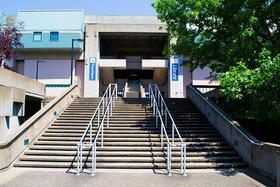School Highlights
Reading Hospital School of Health Sciences serves 288 students (72% of students are full-time).
Minority enrollment is 98% of the student body (majority Black), which is more than the state average of 48%.
Quick Facts (2025-26)
- Enrollment: 288 students
- Acceptance Rate: 29%
- Minority enrollment: 98%
- Source: Integrated Postsecondary Education Data System (IPEDS)
Top Rankings
Reading Hospital School of Health Sciences ranks among the top 20% of public schools in Pennsylvania for:
Category
Attribute
Selectivity
School Resources
School Overview
Reading Hospital School of Health Sciences
(PA) Community College Avg.
Carnegie Classification
Not applicable, not in Carnegie universe (not accredited or nondegree-granting)
Not applicable, not in Carnegie universe (not accredited or nondegree-granting)
Institution Level
At least 2 but less than 4 years
At least 2 but less than 4 years
Institution Control
Private not-for-profit
Private not-for-profit
Total Faculty
n/a
59 staff
School Calendar
Student Body
The student population of Reading Hospital School of Health Sciences has declined by 37% over five years.
The Reading Hospital School of Health Sciences diversity score of 0.42 is less than the state average of 0.68. The school's diversity has grown by 180% over five years.
Total Enrollment
288 students
461 students
Student-Teacher Ratio
n/a
15:1
# Full-Time Students
207 students
325 students
# Part-Time Students
81 students
136 students
# Enrollment Undergraduate
n/a
298 students
# Full-Time Undergraduate Students
207 students
326 students
# Full-Time Graduate Students
n/a
10 students
# Part-Time Undergraduate Students
81 students
151 students
# Part-Time Graduate Students
n/a
12 students
Total Dormitory Capacity
n/a
330 students
% American Indian/Alaskan
1%
n/a
% Asian
8%
5%
% Hispanic
n/a
11%
% Black
12%
15%
% White
2%
52%
% Hawaiian
75%
3%
% Two or more races
2%
3%
% Non Resident races
n/a
1%
% Unknown races
n/a
10%
Diversity Score
0.42
0.68
College Completion Rate (Students who graduate in less than 4 years)
52%
60%
College Completion Rate (Students who graduate in 4 years or more than 4 years)
n/a
36%
Average Graduate Earnings (10 Years)
$52,700
$34,900
Tuition and Acceptance Rate
% Students Receiving Some Financial Aid
100%
88%
Median Debt for Graduates
$15,033
$12,602
Median Debt for Dropouts
$7,626
$5,500
Acceptance Rate
29%
78%
SAT Reading
543
535
SAT Math
509
510
SAT Writing
470
435
ACT Composite
22
19
ACT English (Year 2013)
21
18
ACT Math (Year 2013)
22
20
ACT Writing (Year 2013)
8
7
Source: 2024 (or latest year available) Integrated Postsecondary Education Data System (IPEDS)
Frequently Asked Questions
What is the acceptance rate of Reading Hospital School of Health Sciences?
The acceptance rate of Reading Hospital School of Health Sciences is 29%, which is lower than the state average of 78%. Reading Hospital School of Health Sciences's acceptance rate is ranked among the top community colleges in Pennsylvania with low acceptance rates.
What is Reading Hospital School of Health Sciences's ranking?
Reading Hospital School of Health Sciences ranks among the top 20% of community college in Pennsylvania for: Lowest acceptance rates, Average community college minority breakdown and Percent of students receiving financial aid.
Recent Articles

How to Transfer from Community College to a Four-Year University in 2025
A step-by-step guide for community college students transferring to a four-year university in 2025 — updated strategies, data and expert insights.

Scholarships for Community College Students 2025
Explore updated scholarship programs, tuition data, and expert strategies for community college students in 2025.

The Rise of Technical and Vocational Training in 2025
Explore the 2025 surge in technical and vocational training—enrollment, policy, costs, and why this path is gaining ground for students and parents.









